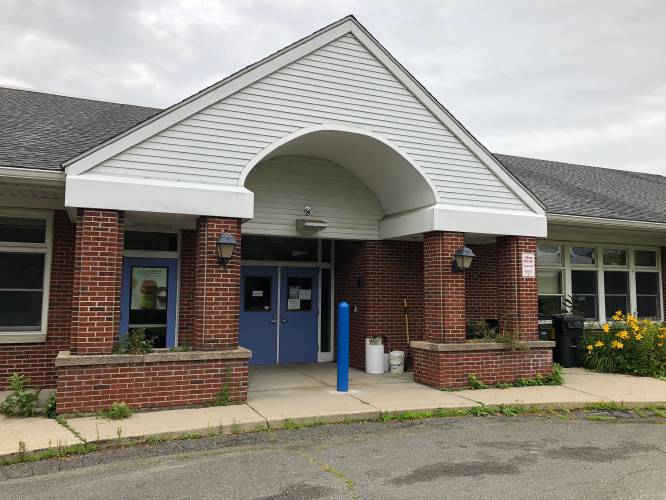Cummington Select Board dives into plans to revive former Berkshire Trail school

The Cummington Select Board met with consultants for two hours last week to discuss plans to convert the former Berkshire Trail Elementary School into space for town offices, a food hub and retail space. gazette file photo
| Published: 09-24-2024 6:21 PM |
CUMMINGTON — Plans to remodel the former Berkshire Trail Elementary School into space for town offices, retail space and a food hub are estimated to cost $8.7 million, a number that officials caution is fluid as they advance plans for a project that has the support of many in the community.
The Select Board met last week with representatives from M&S, a development consulting firm, and Dave Christopolis, executive director of Hilltown Community Development (HCDC), to go over the long-desired project to breath new life back into the 2 Main St. building.
The ongoing plans, currently in a “schematic feasibility stage,” call for splitting the building into eight to 10 commercial rental units, in addition to creating space for the town offices and the food hub that the HCDC would operate.
If successful, the Community House at 33 Main St., currently the location of municipal offices, would return to its original purpose as a community space, featuring an expanded senior center.
Taking into account a 6% inflation rate, the $8.7 million cost estimate includes both $6 million in hard costs for construction of the project and $2.7 million in soft costs, which includes permit and design fees, operating costs for the initial months of operation once opened, the possibility of needing to pay a project manager, and other potential costs.
However, Bob Stevens, co-founder of M&S who joined the two-hour meeting on Sept. 18 via Zoom, said the figure is subject to change throughout the process. Select Board members indicated they believe the resulting total would be lower than the cost estimate anticipates.
“The cost estimate that we got in the schematics and went through the cost estimator was with everything new: new fixtures, new this, new that, new everything,” said Select Board member June Lynds, adding that many of the faucets, windows and other parts of the building may not need to be replaced and refurnished.
According to the data provided by M&S, the town would charge about $10.50 per square foot to lease the commercial spaces in the former school, providing the town with a source of revenue. However, if the site receives a tax credit and the project includes renewable energy features that lower utility costs, the rental rate could drop to as low as $6 per square foot, said Neil Goldberg of M&S.
Article continues after...
Yesterday's Most Read Articles
The Select Board still faces key decisions for the project, such as whether to invest in a geothermal ground source heat pump. This feature would cost $300,000 and would likely be covered by state funding, making it the most cost effective energy choice, consultants informed board members.
These and other design details need to be finalized for the space which currently houses the town’s fiber-optic network hub, but otherwise sits vacant, before construction documents are sent to contractors.
“There’s still ways to go, not the least of which is getting a price so that everyone knows it’s worth it,” said Select Board member Brian Gilman. “We’ve not yet hired any architects or engineering firm to do the construction documents. That’s the next step.”
As of now, the town does not have funding for the project.
“There’s zero in the bank, but we haven’t asked for taxpayer dollars,” Gilman said. “We’ve spent nothing at this point. We’ve been working on this since 2019 and everything has been either volunteer done or grant funded to this point.”
The assessment conducted by M&S cost $35,000, $5,000 of which was paid for by the HCDC for their future share of the space as a food hub.
The town has repeatedly applied for funding through Massachusetts Community One Stop For Growth, a single application that communities can use to apply for various funding opportunities at the state level. The town sent its most recent application last spring and is awaiting a decision.
Additionally, Lynds said that the board requested $6 million in the state economic development bill yet to be approved by the state Legislature. “Fingers crossed,” she said.
A sum of $150,000 had been gifted to the town by an anonymous donor to be used toward any reuse the town envisions, and may be utilized for the project, and the HCDC received a $1 million federal grant with the help of U.S. Rep. Jim McGovern. The Select Board credited the congressman for his efforts to acquire the money for the food hub. That funding is expected to provide kitchen and cafeteria space for food distribution.
“Food insecurity is huge for McGovern, so he is wanting to fund this project to create a food hub,” said Gilman, which would feature a walk-in grocery store, with produce, meat dairy, grains, and delivery services.
The select board explained that the reconfiguring of the former school has received “resounding” support by community members. A petition posted at the Community House in support of the project was signed by approximately 100 residents, or 12% of the community, said Burns.
“The school building closed in 2015,” due to declining enrollment. “It’s almost nine years now. You take a small town of 800, you throw this 23,000-square-foot building in their laps, and you can do something with it,” said Gilman.
The school was built in 1951 and last renovated in 1989. It has been described as structurally solid and received a new roof in 2016. It requires a new heating and cooling system, and costs the town $40,000 in yearly upkeep since its closing.
Samuel Gelinas can be reached at sgelinas@gazettenet.com.






 Rallygoers: Save Social Security
Rallygoers: Save Social Security ValleyBike to expand its reach with 6-8 new stations and 100 new bikes; Westfield joining program
ValleyBike to expand its reach with 6-8 new stations and 100 new bikes; Westfield joining program  Amherst launches red card campaign for immigrant rights
Amherst launches red card campaign for immigrant rights Most incumbents returning to posts in South Hadley
Most incumbents returning to posts in South Hadley
